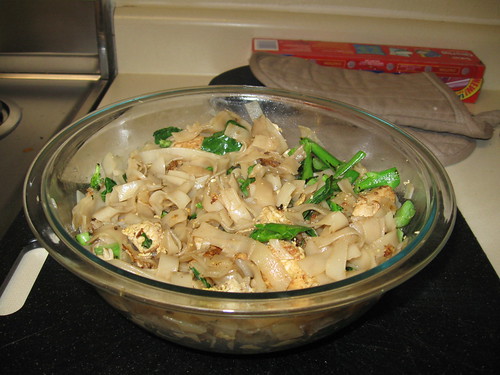Chef fo0bar presents: Pad See Ew
I first tried Pad See Ew (“fried with soy sauce”) at a Thai restaurant in Seattle about 5 years ago, while staking out the city for potential colonization with friends. It was a few blocks our hotel, and we basically ended up going there every other night of the week. But, while there are many Thai restaurants in Reno, very few if any seem to serve Pad See Ew.
Years later, I decided to give it a whirl myself. This was not an original recipe, so I’ll defer to the site I got the recipe from, and just note my experiences:
I did not get thick/dark soy sauce, and instead opted for the “normal” kind. It didn’t really affect anything, in my opinion.
I cut the leaves of the Chinese broccoli from the stems, and cooked the stems before the leaves, as the recipe suggested, but I did not cook the stems long enough. The result was a woody, bitter taste that threw off the final product. In the second batch, I simply left out the stems, and it was great.
I used sesame oil for the cooking as well as the marinade, since I had it available for the recipe. The resulting taste was not unpleasant, but was overpowering. I’d recommend sesame oil for the marinade, but something with a lighter taste for the cooking. The recipe recommends grapeseed oil, which I have no experience, but I’d recommend regular olive oil.
If you don’t have a wok (I don’t), use a large stainless steel frying pan. I did this for the first batch (pictured), which made a horrible mess on the pan (lots of gunk stuck to the bottom of the pan), but in trying to scrape it down as I cooked, the burned bits came off into the dish, and actually tasted great. For my second attempt, I used a large nonstick pan, which was a lot easier to work with, but resulted in a blander flavor.
So, rice noodles. It’s literally rice and water, extruded into noodle shapes and dried. As such, there are a variety of shapes. Pad See Ew is traditionally made with broad rice noodles (about an inch wide, and cut into rectangles). However, all of the local friendly megamarts only seem to carry fettuccine-sized rice noodles. The Asian supermarket on Fifth street carries a variety of sizes, but only seems to up to about 1/4”, which is what is traditionally used for Pad Thai. This is the size I ended up using.
Rice noodles are my new favorite substitution for rice, can be used pretty much anywhere rice is called for, but preparation is completely different. The normal method is simple: Break the noodles out into a large pot of warm water, and let them sit for 30 minutes. All they need is this re-hydration. They can be boiled, but will come out grainy and sticky, and should only be used in a frying situation (but the soak method is still preferred).
